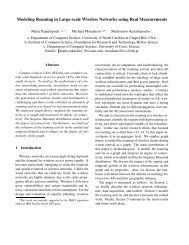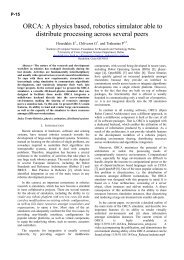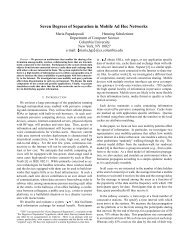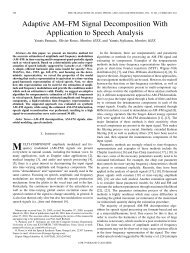Master Thesis - ICS
Master Thesis - ICS
Master Thesis - ICS
Create successful ePaper yourself
Turn your PDF publications into a flip-book with our unique Google optimized e-Paper software.
Computer Science Department<br />
Antonis Misargopoulos<br />
repair cannot remain manual tasks. These requirements resemble the self-organizing and<br />
healing properties of biological systems, and have been termed “autonomic” after the<br />
autonomic nervous system. According to the definition in [12], an autonomic system has<br />
the following properties:<br />
• needs detailed knowledge of its components and status;<br />
• must configure and reconfigure itself dynamically;<br />
• seeks to optimize its behavior to achieve its goal ;<br />
• is able to recover from malfunction;<br />
• protects itself against attack;<br />
• is aware of its environment;<br />
• implements open standards; and<br />
• makes optimized use of resources.<br />
The third generation Grid systems now under development are beginning to exhibit many<br />
of these features. In the following section we describe the nature of a Grid with respect to<br />
architectural components and services.<br />
2.4 The Nature of the Grid Architecture<br />
In this section, we identify requirements for general classes of components in the Grid<br />
architecture. The result is an extensible, open architectural structure within which<br />
solutions to key VO requirements can be placed and which is organized in layers, as<br />
shown in figure 2.1. In specifying the various layers of the Grid architecture, we follow<br />
the principles of the “hourglass model” as presented in [1]. The narrow neck of the<br />
hourglass defines a small set of core abstractions and protocols e.g., TCP and HTTP on<br />
the Internet, onto which many different high-level behaviors can be mapped (the top of<br />
the hourglass), and which themselves can be mapped onto many different underlying<br />
technologies (the base of the hourglass). By definition, the number of protocols defined<br />
at the neck must be small. The neck of the hourglass consists of Resource and<br />
Connectivity protocols, which facilitate the sharing of individual resources. Protocols at<br />
these layers are designed so that they can be implemented on top of a diverse range of<br />
resource types, defined at the Fabric layer, and can in turn be used to construct a wide<br />
12

















